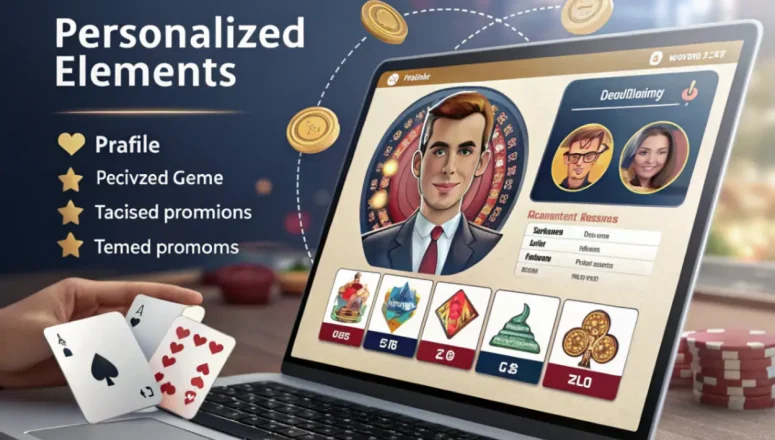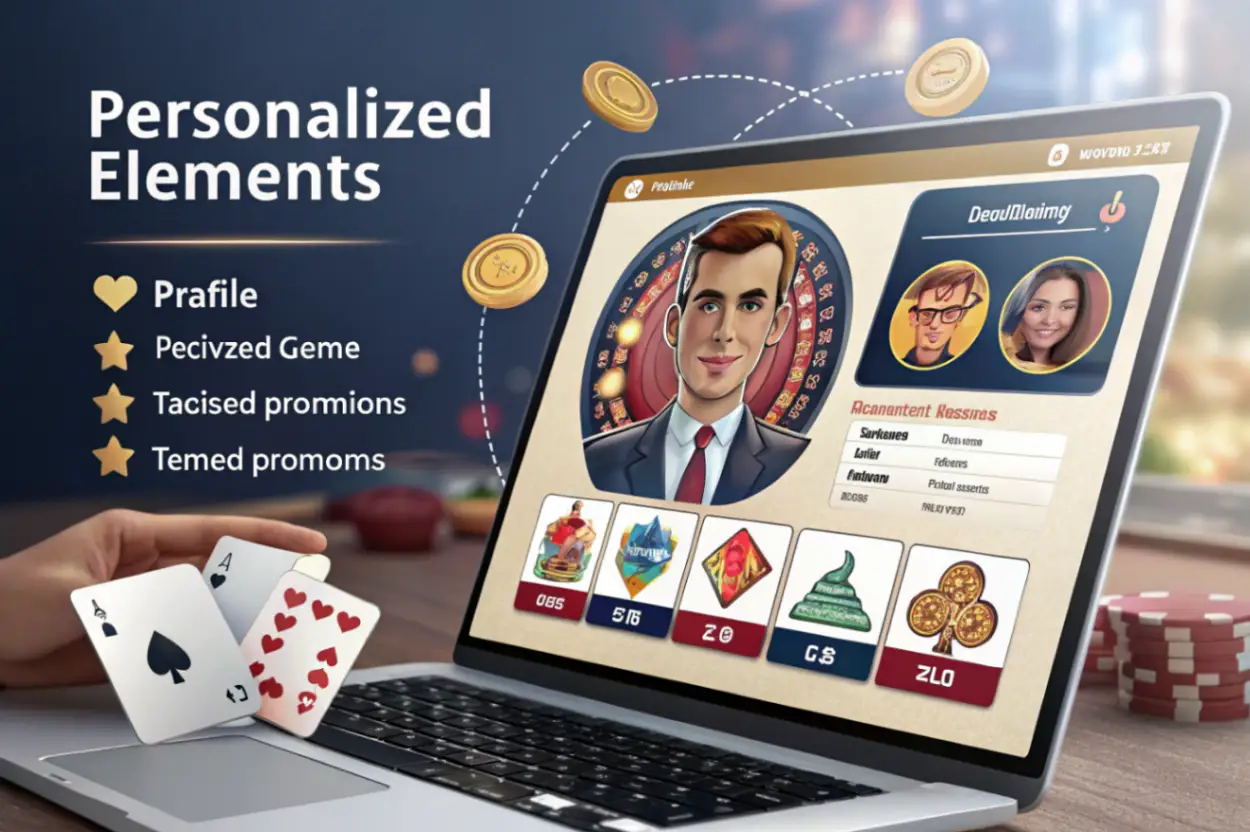In the rapidly evolving world of online gambling, personalization has become one of the most powerful tools for attracting and retaining players. What was once a static experience with the same interface for everyone has transformed into a dynamic and adaptive journey that responds to each player’s preferences, habits, and emotions. Online casinos are no longer just platforms for games — they are interactive ecosystems designed to understand the player. This evolution mirrors a broader digital trend: the expectation that every user interaction should feel personal and intuitive.
The personalization process in online casinos combines behavioral analytics, AI-driven design, and UX psychology. It starts from the moment a player registers — tracking their game choices, playtime, bet sizes, and even pauses during gameplay. This constant feedback loop allows the casino to tailor the interface, recommended games, and promotional offers in real time. Essentially, the interface becomes a mirror of the player’s behavior.
The Psychology Behind Personalized Design
Understanding why personalization works begins with human psychology. People respond positively to familiarity and recognition. When an online casino “remembers” a player’s favorite slot or preferred theme color, it builds an emotional connection. That subtle sense of being seen — even by an algorithm — triggers engagement and loyalty.
Psychologists often refer to this as the “mirror effect,” where users are more likely to trust and enjoy environments that reflect their identity. Online casinos take advantage of this through design elements such as dynamic color themes, adjustable sound profiles, and personalized game recommendations. For example, a player who prefers low-stakes poker might see calmer colors and simplified interfaces, while high-roller users experience bolder visuals and premium animations.
The ultimate goal is to reduce cognitive friction. A personalized interface removes unnecessary complexity, guiding players smoothly toward games or features that align with their mood and motivation. When done right, personalization doesn’t feel like marketing — it feels like comfort.
How Data Shapes the Personalized Experience
Data is the engine behind every adaptive casino interface. It tells the system what to show, how to display it, and even when to highlight certain features. Every click, every bet, and every second of inactivity provides valuable insight. Through data analysis, casinos can identify patterns such as when a player tends to log in, which games they play longest, and what types of bonuses attract them most.
Before diving into the details, it’s important to clarify one thing: personalization does not mean invasion of privacy. Modern casino platforms operate under strict data protection laws such as GDPR and require user consent before collecting behavioral data. The focus is not on who the player is, but how they interact with the platform.
In practice, personalization can be seen through features like dynamic dashboards that highlight current tournaments or AI-generated suggestions for “Games You Might Like.” Some casinos even adjust their homepages based on the time of day, offering light modes for daytime sessions and darker tones at night. This combination of technology and psychology enhances engagement while maintaining comfort and trust.
Adaptive User Interfaces and AI Algorithms
The true magic of personalization lies in the combination of AI and UX design. Artificial intelligence doesn’t just analyze behavior — it predicts it. Using machine learning models, online casinos can anticipate when a player might lose interest and introduce a new game or bonus at exactly the right time. This kind of predictive adaptation transforms a static interface into a living, responsive environment.
AI-driven personalization works in several layers. First, it processes large datasets to identify correlations between actions and outcomes. Then, it applies those insights to modify the interface in real time. This may include reorganizing the game grid, adjusting font sizes for better readability, or changing the order of categories based on popularity. The player may not even notice these shifts consciously, but the experience feels more fluid and enjoyable.
Such adaptability also plays a vital role in accessibility. By understanding user preferences, casinos can optimize interfaces for different devices — smartphones, tablets, or desktops — ensuring consistent comfort across platforms. This inclusivity is part of why personalization has become a standard, not a luxury, in modern iGaming.
Personalization Through Rewards and Game Suggestions
One of the most visible aspects of personalization is how casinos structure their rewards and recommendations. Bonuses are no longer generic; they are data-driven incentives designed to resonate with specific user profiles. For instance, frequent slot players might receive free spins on their preferred machines, while table-game enthusiasts are offered cashback rewards.
To understand how these systems work, it helps to look at the following table, which illustrates the relationship between player behavior and personalization features.
Example of Behavioral Personalization in Online Casinos
| Player Behavior Pattern | Personalization Feature | User Experience Outcome |
|---|---|---|
| Frequent slot play with small bets | Custom slot recommendations and themed rewards | Higher engagement through familiarity |
| Sporadic play on weekends | Time-sensitive weekend bonuses | Increased retention and weekend activity |
| High-stakes betting on live games | Exclusive VIP tournaments and dark-themed UI | Sense of prestige and exclusivity |
| Frequent mobile play | Optimized mobile interface with simplified navigation | Improved accessibility and satisfaction |
| Preference for classic games | Retro interface mode and curated “nostalgia” section | Emotional connection and user comfort |
As seen above, personalization is more than just aesthetics — it’s an emotional and behavioral strategy. By responding to patterns, the casino creates a feedback loop where players feel rewarded for their habits, reinforcing continued play.
The table also highlights another key point: effective personalization must balance user enjoyment with ethical responsibility. Over-targeting can make the experience feel manipulative, so transparency and consent are critical.
Dynamic Layouts and Emotional Engagement
Design is not just visual; it’s emotional. In online casinos, adaptive layouts have become the bridge between usability and engagement. A player’s journey through the site is subtly guided by visual cues — color temperature, animation speed, and game placement. AI algorithms detect micro-patterns such as cursor movement or scrolling speed, allowing the system to adjust elements dynamically.
For instance, if a player hovers frequently over slot games but doesn’t click, the interface may enlarge those icons or move them higher on the homepage. Similarly, players who navigate quickly between categories might see a simplified layout to reduce cognitive load. This constant adaptation creates the impression that the casino “understands” the player.
Within this context, emotional engagement becomes measurable. The design doesn’t just react to what players do — it anticipates how they feel. A bright, energetic interface can enhance excitement during wins, while softer visuals and sound transitions can ease frustration after losses. This emotional rhythm keeps the experience balanced and immersive.
In some cases, casinos integrate gamification layers such as progress bars, avatars, or missions to further deepen personalization. These features make the player feel part of an ongoing narrative rather than isolated sessions.
Responsible Personalization and Player Protection
While personalization enhances user satisfaction, it also carries ethical implications. Online casinos must ensure that adaptive interfaces do not exploit behavioral vulnerabilities. Transparency is key — players should always understand when and why their experience is being tailored.
Responsible gaming tools are now being integrated directly into the personalized environment. For instance, if AI detects prolonged sessions or risky betting patterns, it can subtly introduce reminders, limit-setting options, or cooling-off features. This kind of “protective personalization” turns technology into a safeguard rather than a temptation.
To illustrate this balance between engagement and safety, consider a few guiding principles that define ethical personalization in iGaming.
Before reviewing them, it’s important to note that these are not rigid rules but evolving best practices developed through ongoing research and regulation.
Personalization should always prioritize user well-being over profit.
Transparency about data collection and use builds trust and long-term loyalty.
Adaptive tools must include features that help players maintain control of their gameplay.
These principles form the ethical backbone of modern personalization systems. By adhering to them, online casinos can deliver engaging experiences without crossing into manipulation or excessive influence.
The Future of Personalized Casino Design
The evolution of personalization in online casinos is far from over. In the near future, AI will integrate with biometric technologies, enabling even deeper adaptation. Facial recognition and emotion detection could allow systems to read players’ expressions and adjust the interface in real time — dimming lights when frustration peaks or offering calming animations during pauses.
At the same time, personalization will become more holistic. Instead of focusing solely on gameplay, casinos will expand adaptive design to cover the entire user journey: registration, payments, loyalty programs, and even customer support. Chatbots powered by natural language processing will offer tailored responses, making every interaction feel one-on-one.
However, with this growing sophistication comes responsibility. Regulators and designers alike must ensure that personalization serves as a tool for empowerment, not control. The ultimate goal is to create environments that respect individuality while fostering fair play and emotional balance.
Conclusion: A New Standard in Digital Interaction
Personalization has turned online casinos into responsive, human-like interfaces that evolve with every click. It combines technology, psychology, and ethics to deliver experiences that feel alive and intuitive. Players are no longer passive participants but co-creators of their environment — their behavior literally shapes the casino around them.
In the future, this adaptive design philosophy will likely extend beyond gambling into other sectors of entertainment and e-commerce. For now, it defines the cutting edge of digital gaming, where every spin, card, or bet is not just part of a game but part of a personalized journey.


